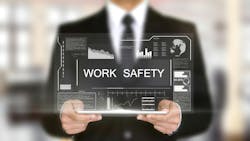The Continuing Evolution of Safety Training
Imagine this scene. Walking into today's safety meeting everyone is handed an augmented reality headset. Once the device is activated, each person virtually experiences the exact same incident that had occurred earlier at the plant. Each worker is able to run through various options and scenarios that play out how the incident could have been avoided.
That is the endgame for Thomas Pitts, Schneider Electric’s director of safety and environment for Services and Solutions Group in North America. “People learn more when training is hands-on,” Pitts says. “This [augmented reality] method allows people to understand specifically what happened in an incident and what could have been done differently.”
Pitts has set Schneider Electric, a global provider of energy management and automation, on course for this dream to become reality. “What has changed over the past few years, in terms of technology, is that people are able to be trained on a variety of devices, such as computers, tablets and smartphones. They can train however and whenever they want—even on their own time, if they would like.”
While it might seem odd for people to train on their own, it’s exactly what employees at the company are doing. Safety surveys, conducted annually, have shown over the past three years that safety training is what employees are most interested in. “People can create learning methods that work best for them,” says Pitts. “They can choose the pace, take breaks and review material again.”
This move toward individualized training is part of an overall company strategy. “Since COVID, there are two words that describe our training strategy: tailored and efficient,” explains Pitts.
The amount and type of training depends on an individual’s role. To offer a wide array of training, the company partnered with Underwriters Laboratory (UL) to offer employees the entire training catalog. “We can now tailor training specifically on job codes,” says Pitts. For example, driver safety is one of their top five safety concerns. Therefore, a large investment has been made to provide continuous training, including microlearning. “We can assign different learning, once a month, to make sure information is always fresh in people’s minds.”
Emphasizing the Individual
This emphasis on the individual is something that Rick Tobin, CEO of SafetyNow, a provider of safety training courses, is seeing in the market as well. “The onus has moved to the individual, and we are seeing this across the board as part of an overall business transition,” says Tobin. “For a long time, behavior-based training was the preferred method, but now it’s more focused on individual safety and accountability. However, in order for training to be effective, it has to be measured. If you are placing accountability on the individual, how are you measuring that individual’s contribution?”
Measuring, using data analytics, is how Schneider decides what training is necessary. “Whenever we do have an incident, or any near misses, we look at trend analysis,” explains Pitts. “For example, since many employees work with metal, cuts and burns occur, so we tackle those hazards in real time, instead of waiting for safety reports to tell us why this happens. We can use artificial intelligence (AI) to provide this data.”
The company doesn’t use traditional metrics either. “We don’t look at lagging metrics; instead, we look at proactive activities,” says Pitts. In fact, proactivity is included in safety performance metrics for managers. “Safety activities and actions are part of their performance review. How many safety activities they conduct, including audits, walking the plants, behavior-based training or talking to employees one-on-one are measured.”
And measurement is solidified by yearly reports, third-party audits as well as audits at each site.
Due to the nature of the products Schneider makes, safety extends in both directions. “We want the equipment that we make to be as safe as possible for our customers,” Pitts says, “and the same goes for our people who are building, installing and servicing equipment. We want to make sure they are safe when they are doing those tasks.” These efforts have paid off as Schneider is one of a small number of companies that have won both the Robert Campbell Award and the Green Cross Award issued by the National Safety Council.
Remote Training
A large part of tailoring learning is being able to use technology to offer remote training. Schneider has partnered with third parties to conduct live remote training. Of course, anything done remotely can offer challenges, and Pitts has found that to avoid distractions and encourage engagement, cameras are turned on during training and microphones are open so that conversations are two-way, and more questions can be answered during the training.
This expanded delivery of training has impacted how companies are able to offer a variety of courses, says Tobin. “When companies were required to do cross-company training, mostly for the top 10 OSHA issues, it was costly. But once the pandemic hit and people went to remote training, it became a different landscape. Once they adopted this efficient method for training, many then applied that to a variety of training, including soft skills.”
Especially with constant regulatory changes, remote training offers an efficient delivery method. “If companies need to meet certain requirements in some states, it’s just as easy to roll out that training across the entire country,” notes Tobin.
Determining the effectiveness of this training is essential. In a recent survey conducted by SafetyNow on the state of the training market, for the first time there was a significant response from safety leaders looking at AI. “Using AI to assist in metrics is valuable in that you can tie the safety metrics to overall business metrics. And as adoption of AI expands, I think companies will see safety training as part of overall corporate efficiency and productivity initiatives, and realize the investment provides a return,” Tobin says.
Continuous Improvement
At Schneider, to ensure that their training is top notch, at the end of each training module, employees are asked to rate the trainer and to offer suggestions for improvement. “You miss a lot when you just certify that the information was understood, but don’t go further,” Pitts points out. “We need to make sure that the training is good. And we need to know which topics people are interested in.”
This feedback could be the reason that four years ago the company started offering training in psychological safety, a topic that most companies are just now beginning to explore. Every year Schneider conducts safety culture surveys, looking for gaps, and then they introduce courses to fill those gaps. On the subject of psychological safety, Schneider is focused on training both managers and employees to widen their perspective when it comes to what causes incidents. “We try to help our managers and employees understand the human factors that could explain why incidents occur, and help them learn what they can do to combat different factors, such as fatigue or complacency,” says Pitts.
As safety training evolves and continues to focus on both the human aspect as well as individual accountability, it will be technology, once thought to be highly impersonal, that will in fact make the personal aspect of safety improve.
About the Author
Adrienne Selko
Senior Editor
Email [email protected]
Adrienne Selko is also the senior editor at Material Handling and Logistics and is a former editor of IndustryWeek.

